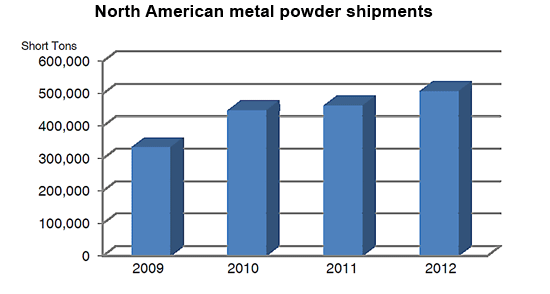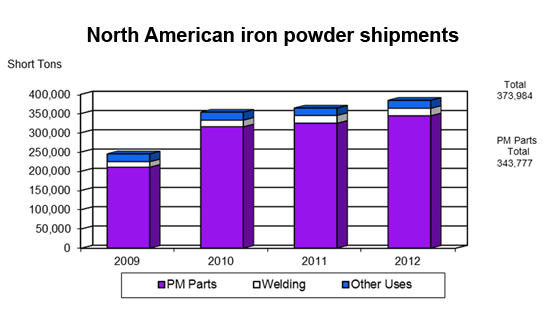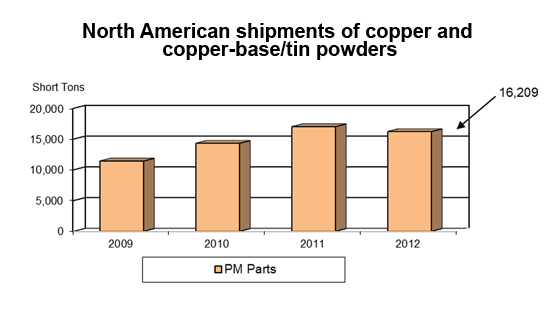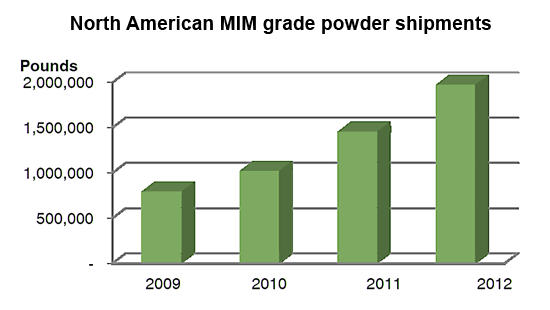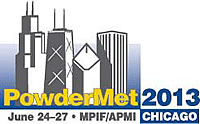PowderMet 2013: State of the North American Powder Metallurgy industry – 2013
A keynote presentation by MPIF President Matthew Bulger (NetShape Technologies) gave delegates a detailed overview of the state of the North American Powder Metallurgy industry.
The North American PM market in 2012
In his opening address Bulger reported that most metal powder producers, equipment makers and PM parts companies, especially fabricators of Metal Injection Moulded (MIM) parts, had reported increases in sales during 2012. The industry, he stated, has regained its growth momentum and 2013 is expected to offer a repeat of last year’s modest but positive gains.
Bulger reported that total 2012 metal powder shipments increased by 9.6% to an estimated 507,643 short tons (Fig. 1). Iron powder shipments in 2012 rose 5.5% to 383,984 short tons, representing the third consecutive year of steady growth. Of this total the PM parts share grew by almost 6% to 343,777 short tons (Fig. 2).
North American shipments of copper/copper-base and tin powders for PM applications actually declined last year by 4.7% to 16,209 short tons, stated Bulger (Fig. 3).
Of the other materials, tungsten and tungsten carbide powders registered minor declines, while stainless steel, molybdenum, and nickel powders experienced modest gains. Recent new information on aluminium powder shows a substantially larger market than previously reported at some 80,000 short tons.
According to MPIF statistics, the market for MIM powders grew 35.5% in 2012 to 1,971,580 pounds (895 mt). However, because these statistics do not include all powder makers, observers put the market higher at approximately 2-3 million pounds, added Bulger (Fig. 4).
PM process equipment makers, especially compacting press builders, highlighted an upward trend by part makers to increase their manufacturing capacity for PM parts. Press sales registered very strong gains last year compared with 2011, and the industry ended 2012 with a backlog of more than $19 million, reported the MPIF’s Powder Metallurgy Equipment Association.
“PM parts makers serving the automotive market fared very well last year, while those serving the industrial market and products related to home building experienced more modest growth,” added Bulger.
MIM companies recorded a solid year of increased sales in 2012. The hot isostatic pressing (HIP) industry enjoyed another outstanding year as well, based on casting densification and the processing of MIM parts to full density.
2013 outlook for North America
Turning to current conditions, Bulger said that even in the face of robust auto sales, a recovering US manufacturing base, and a rebound in new home construction, PM executives still forecast only modest growth because consumers remain wary about the US economy.
Iron powder shipments through the first four months have increased 6.7% to 136,535 short tons. Copper-powder producers are cautiously upbeat, stated Bulger, forecasting annualised growth in the 3 – 6% range.
Equipment makers anticipate increased business levels based on capacity expansions among PM parts fabricators, especially the addition of presses in the 100 to 500 ton range.
Bulger reported that larger multi plant PM parts makers, especially auto-parts suppliers, are adding new capacity to meet growing demand. Some medium and smaller size family owned businesses, who supply the broader industrial marketplace, are signalling a mixed outlook.
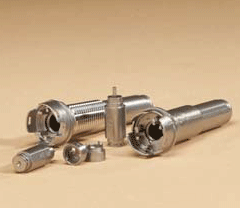
Fig. 5 Metal Injection Moulding continues
to find new applications in the automotive
sector. This sensing element, port and
ring, manufactured by Indo‐US MIM Tec
Pvt. Ltd, recently won a 2013 MPIF
Design Excellence Award Grand Prize
The MIM industry continues to thrive with annual North American sales estimated at $250 -$300 million. Firearms applications remain the leading MIM parts market followed by medical/dental, general industrial products, automotive, and electronics. As far as the automotive market is concerned, there are applications where MIM technology is indispensable, in components for electric and hybrid vehicles and in new turbocharged gasoline engines.
The Hot Isostatic Pressing (HIP) outlook signals another good year that should continue well into the future, commented Bulger. Although casting densification dominates HIP usage, representing about 70% of the market, PM applications are also growing for MIM part densification, tool steels, and oil- and gas-exploration projects.
Weakening demand characterises the tungsten market outlook along with softer raw materials prices. Both the carbide and tungsten alloy shipments were down during the first quarter, particularly tungsten carbide products in mining and construction industries. Defence applications are also down, heavily impacted by the government’s sequestration program. However, oil and gas drilling applications are doing well, and aerospace applications are on an upward trend.
PM automotive trends
“This year could see North American light vehicle production rising well above 15 million units. However, the really big increases should hit the market in 2015-16 when many new models with new engines and transmissions are introduced,” stated Bulger. “This trend includes more four and six cylinder engines, turbochargers, and six, seven, and eight speed transmissions. The use of variable valve timing (VVT) systems will continue to grow in order to help OEMs meet 2016 CAFE standards,” he added.
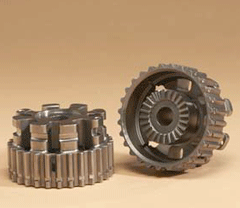
Fig. 6 This automotive compressor clutch
manufactured by AMES S.A., Barcelona,
Spain, was awarded a 2013 MPIF Design
Excellence Award Grand Prize
It is estimated that the PM parts content in the typical US made car, can be as high as 1,000 individual parts representing 325 applications, and will increase slightly to 44.5 pounds (20.2 kg) this year. This compares with 44 pounds (20 kg) in 2012, which had increased two pounds from the previous year. In contrast, the PM content in the typical European built car remained even last year at 19.4 pounds (8.8 kg), while the PM content in the typical Japanese car declined slightly to 20 pounds (9.1 kg). Both countries experienced a decline in vehicle production, added Bulger.
Powder Forged (PF) connecting rods remain one of PM’s stellar successes, dating back to its first use in North America in a Ford 1.9 litre engine. About 60% of North American auto engines use PF rods currently. Worldwide, it is estimated that more than 850 million PF rods have been produced since 1987, with no major failures reported.
Technology developments
“Metal powder producers continue to invest in programmes to improve PM materials and expand PM parts applications,” stated Bulger. “For example, one company is developing a new high density lubricant binder that provides higher single pressed densities via warm compaction. A competitor is working on developing new lubricants with improved hygroscopy resistance and ejection. Another company has a new line of stainless steels that improves machinability two to three times over standard stainless grades.”
“Compacting press builders are designing enhanced high tonnage CNC hydraulic presses and higher speed designs,” continued Bulger. “Several firms are focused on supplying PM parts for an innovative stationary fuel system that converts natural gas to oxygen and hydrogen to produce electric energy.”
Additionally, researchers are studying powder based composites for defence and energy applications. Potential uses include aluminium alloys for lighter-weight marine and armoured vehicles, iron based soft magnetic composites for motors, compressors, and power conversion, and nanomaterials for nuclear energy, solar, and space applications.
Addressing the topic of Additive Manufacturing (AM), Bulger noted that laser-sintering 3-D printers show promise sintering metals for complex aircraft parts.
A bright future
“Investing in applied and fundamental research is vital to our industry’s future,” stated Bulger. “Technology breakthroughs may take years before true commercial applications, but we must never neglect researching new ideas and funding them. In the context of the worldwide metals and materials fields, PM may be a blip on their radar screens. But on the other hand, many industries would grind to a sudden stop without our vital technology.”
“PM was heralded as a twentieth century technology based on superstar products, and it will gain new status as a global technology in the twenty-first century. That is, if we encourage that insatiable curiosity to conceive new ideas, maintain the entrepreneurial spirit of the pioneers who launched the PM industry, and cooperate through joint development programs worldwide,” concluded Bulger.
Images from PowderMet 2013
Below is a gallery of photographs taken at PowderMet 2013. Click on the thumbnail to enlarge the image.
Posted by: Paul Whittaker, Editor Powder Metallurgy Review & ipmd.net
News | Articles | Market reviews | Search directory | Subscribe to e-newsletter



